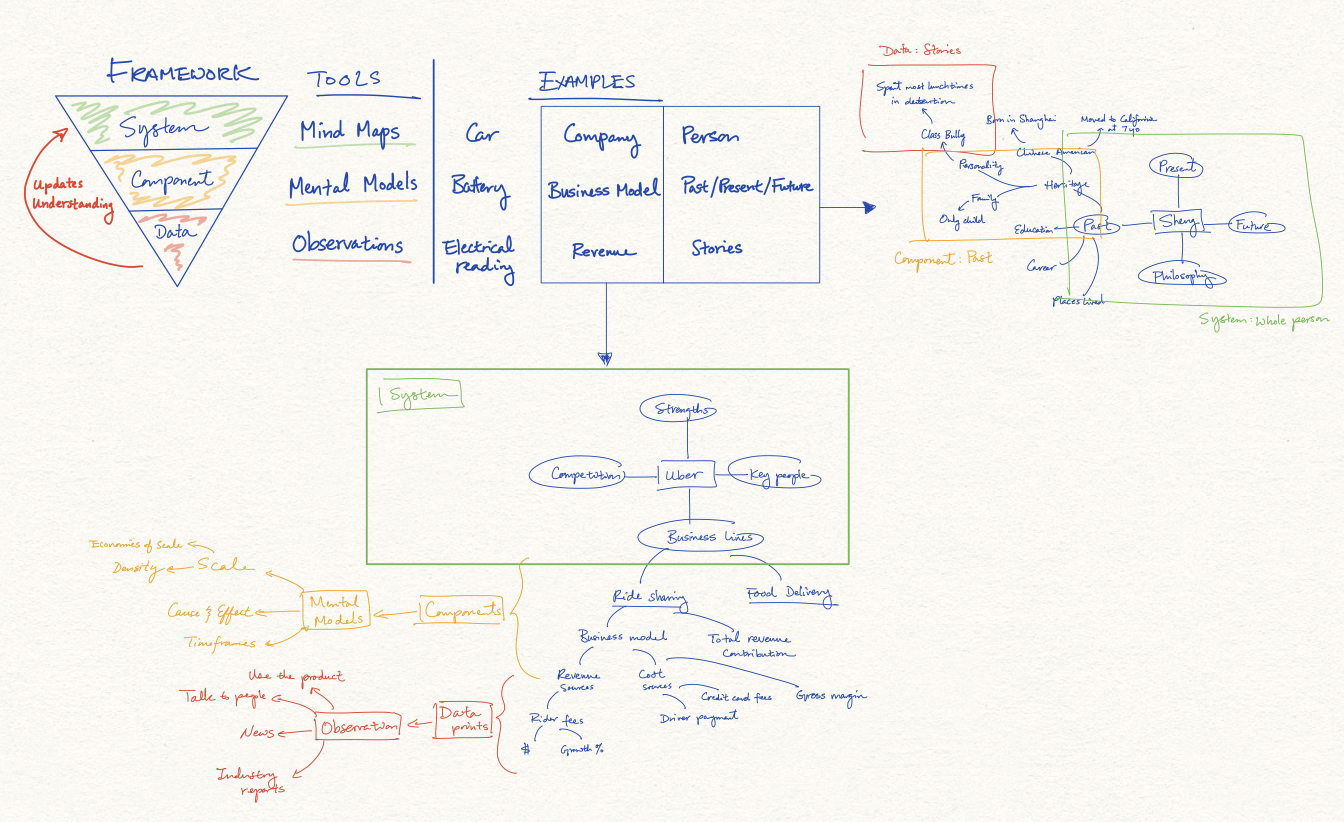Intro to Systems Thinking - Bust Any Complexity
Despite how much I preach about Mind Maps, they're only one tool in a larger kit, which is System Thinking.
First, what's System Thinking? According to one source, it's a holistic approach to analysis that focuses on the way that a system's constituent parts interrelate and how systems work over time and within the context of larger systems.
OKAY that's a lot of SYSTEMS! In plain english, it just means looking at things as a whole AND its parts in order to understand its nature. And once we truly understand something, we can better relate to it, troubleshoot it or work with it.
My system thinking framework has three layers, which is the same process I apply to every mind map:
Sharp eyes will recognize the similarity of this top-down funnel to the Goals framework in the Intentional Productivity field guide. That's because it follows the same logic!
At the highest level is the System itself, which is defined by the topic I'm trying to understand. It's important to set your boundaries around your objectives so you're not wasting time, which is surprisingly easy to do. If you ever tunneled down a Wikipedia rabbit hole, you know what I’m talking about. Using a car analogy, the System is the whole vehicle. How I analyze the car depends on how what I'm trying to do. Am I diagnosing a problem as a mechanic or designing a new electric vehicle for Tesla? When I first make a mind map, I'm basically drawing my initial understanding of reality - in other words, a hypothesis.
Next is the Component level, which is where we start breaking the car down into its parts like the engine, transmission, battery, radiator, axels, and brakes. Each of these components serve their own purpose. If I were a mechanic, my objective at this point is to identify which components are relevant to the question at hand. As I expand the mind map, I'm asking myself what contributes to the greater whole.
Finally at the Data level, I'm observing how the individual components are working to fulfill their purpose. As a mechanic, this is where I'm taking out my readers, scanners, and gauges to check up on the components in question. My job is to simply observe, rather than judge at this level. But as I collect more data, it will inform how my mind map is drawn and connected.
Mental Models and Judgment
We are all naturally prone to cognitive biases that cloud our judgment. To think more objectively, I try to withhold judgment at the Data level and then apply mental models at the Component and System levels after I've collected enough data and have a chance to lay them out.
What are mental models? They're a simplified representation of how things in reality work. For example, the supply and demand model in economics is a powerful idea to understand how market dynamics work. It's too simple to fully capture the real thing, but it allows us to quickly grasp the essence of something otherwise very abstract and difficult to describe.
Charlie Munger, Warren Buffet's business partner, puts it well:
"Well, the first rule is that you can’t really know anything if you just remember isolated facts and try and bang ’em back...You’ve got to have models in your head. And you’ve got to array your experience both vicarious and direct on this latticework of models. You may have noticed students who just try to remember and pound back what is remembered. Well, they fail in school and in life. You’ve got to hang experience on a latticework of models in your head.”
Well, that's what mind maps are. A literal latticework of mental models. Though the part about failing in school and life is a little harsh, I admit.
Below's an example of how I would apply mind mapping in concert with mental models to better understand a company like Uber, which I had to do as a strategist in my prior life in tech.
I'd first start at the System level by mapping out roughly what I think is important and relevant for me to know, such as its management, competition and business lines.
Then I'd break out those Components into their sub-components, like ride sharing and food delivery under business lines. And keep breaking them down until I hit the most granular building blocks, the Data level. Once I mapped out the components and collected enough data (through news, financial reports, using the app, talking to people etc), I can start applying various mental models to the analysis. This is exactly how I broke down Meta and Snapchat in the last two newsletters.
I won't go further into mental models this week, as I'll be covering the ones I use in future issues. For now, all I'll say is that if you practice these techniques enough, it'll eventually become second nature and vastly improve your ability to think in a more structured and objective way.
Steel Tools with a Silver Heart
Can you apply these "Steel tools" to Silver issues like relationships and our personal lives? Absolutely. I've used this to create concepts like the 3rd Line framework for meaningful living and the personal Verb idea, which is a Silver mental model.
I've also created mind maps to better understand myself and those close to me. Here's an example.
In this case, the “System” is the person. The Component might be his Past, Present, Future Aspirations, and Personal Philosophies. The base Data points are the stories. We are all multifaceted human beings and this is one way to honor our individual complexities, withhold judgment of personal stories, while trying to understand a person as a whole.
I'll also be diving into more ways I use mind mapping to tackle our internal struggles in future issues. Thanks for making it to the end, now I can ambush you with the kitchen sink ;)
📺 For those of you who prefer a video lesson, here it is.




